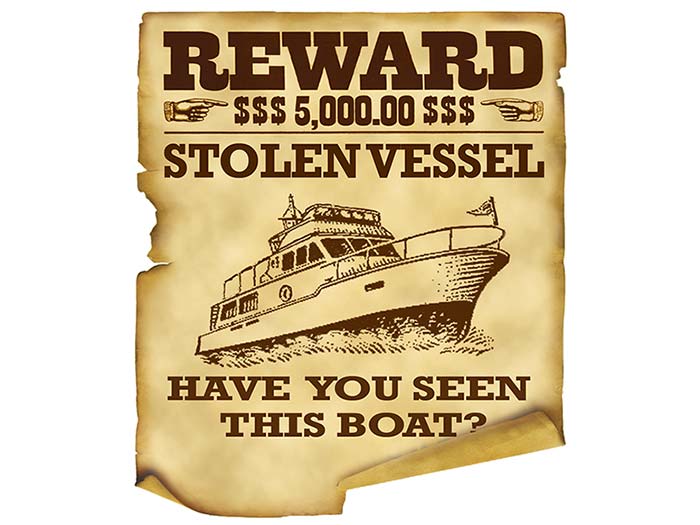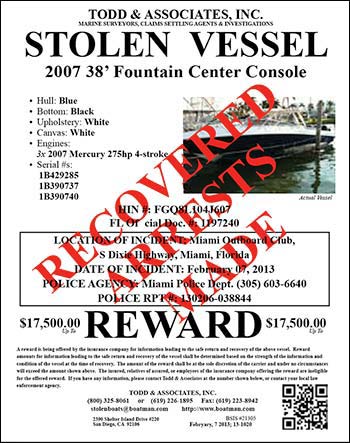Advertisement
Marine investigators tracking down missing boats can end up in some unlikely places.

It's safe to talk about now, probably, but at the time, sitting in the office of the leader of an international gang in San Francisco, Todd Schwede and Dan Rutherford were sweating bullets. Schwede is the head of Todd & Associates, which specializes in marine surveys and investigations. The company is based in San Diego, but they go where the work takes them, which can run the gamut in the world of international boat theft. Rutherford is the director of claims and risk management at Maritime Program Group in Boston. They've investigated hundreds of cases, together and separately, and they sat down to tell BoatUS about some of them at a recent convention of the International Association of Marine Investigators (IAMI) in South Carolina.
As investigators, Schwede and Rutherford make their living by expecting the worst of people, like the time Rutherford was called in to investigate the "theft" of a 40-foot O'Day sailboat. Turns out two geniuses had bought a couple of salvaged boats after a hurricane, glued the two "good" halves together, then tried to make a claim on the boat they'd chopped up. Rutherford was suspicious, but when he noticed the boat was two different colors on the inside, he knew for sure that something was up.
Getting The Word Out
Schwede and Rutherford don't seem cynical, but distrust is an occupational hazard when you've been lied to as much as these two have in their combined 66 years in the business. And sometimes, in this line of work, you're going to have to sit under the watchful gaze of a huge bodyguard as you listen to a gang leader tell a story about his boat being stolen, when you know full well that he paid someone to steal it.
"This was his third strike," under California's three strikes law, Rutherford deadpans. "You know what his second strike was? Murder."
The gregarious Schwede is known in marine-investigation circles as the guy who gets the word out, fast. When the first fax modems came out for computers, he seized on the idea of using it to blast stolen-boat wanted posters to marinas, repair shops, surveyors, and anyone else who regularly came into contact with boats, to get as many eyes as possible searching for the vanished vessels. His stolen-boat files are now online (at boatman.com), but despite the technological boost, he really specializes in old-fashioned word of mouth.
For example: A couple of few years ago, a 38-foot center-console Fountain powerboat, worth more than $150,000, was stolen from a venerable Miami boating club. The insurance company called Schwede who sent out a flyer and posted the boat online, along with the promise of a reward of up to $17,500. One of the people who saw the flyer was a towboat captain in the Grand Bahamas, who recognized the boat at a local yard two weeks later. He called it in. The hull identification number (HIN) had been removed, but a Florida registration number was left on the hull, and the captain gave it to Schwede and the Bahamian police, who made an arrest. It turned out the towboat captain wasn't the only one who saw the flyer. The alleged thief had a copy pinned to his refrigerator.
The Case Of The Missing Numbers
The case of the missing Fountain is atypical. For starters, it was recovered. According to the National Insurance Crime Bureau (NICB), of the boats stolen, typically only about 40 percent of boats make their way back home. BoatUS stats show that trailerable boats have even less chance of being recovered. There may be some hope for the rest — Schwede and Rutherford say they've recovered boats years after the theft — but the fact remains that boats are fairly easy to steal, and hard to track down once they're gone.
Advertisement
The Fountain was also reported as stolen and recorded in national databases with an accurate HIN. But participation in the FBI's National Crime Information Center reporting program is voluntary; industry sources suggest the real number of boats stolen could be two to three times what's reported. The NICB was formed 100 years ago as the National Automobile Theft Bureau as a way for insurance companies to band together to prevent auto theft, and stolen cars still serve as the model for investigating stolen boats. Every car has a 17-digit vehicle-identification number that can be run through a formula to reveal who made it, when, and where, as well as a mathematical algorithm to see whether it's a valid code, similar to the ones used by credit-card companies. The same system is used to report stolen boats. But a boat's HIN only has 12 digits. Schwede and other investigators say those missing digits are a big hurdle in identifying stolen boats. Police officers in agencies all over the country, so used to entering 17-digit VINs, add zeros and all sorts of other permutations to make that 12-digit number into 17 numbers, inadvertently making a match impossible.
Following The Leads

IAMI and other organizations, along with BoatUS, have lobbied for a standardized, 17-digit hull identification number, but those efforts haven't gained traction. The current identification number, while required by the U.S. Coast Guard, was never meant to be used for theft investigations. Its purpose is to facilitate manufacturer recalls. A few years ago, the National Marine Manufacturers Association and NICB announced that they were setting up a database of ID numbers and other information voluntarily provided by manufacturers. That effort has received support from IAMI (and from BoatUS). Commercial interests have also attempted to step into the gap. Former police detective Paul Robinson and his company HINvalid are able to check identification numbers against their database of boat registrations provided to the states. Robinson believes his system is the best around, but the check still has limitations.
Absent a national registration scheme, investigators like Rutherford and Schwede will have plenty of work, relying on word of mouth and their own experience to spot the things that look out of place, and follow the clues wherever they lead. A few years ago, Schwede and investigator Charlie Meacham investigated the theft of a race boat. The case began to crack when Meacham found a gas-station attendant who saw the boat when the truck towing it stopped to refuel. The theft, which happened in Texas, turned into a sprawling, multistate investigation that brought down some of the biggest names in offshore racing.
And then there was that gang leader. Schwede and Rutherford stumbled into the investigation when Rutherford was asked by an insurance company to look for a stolen boat. It turned out that not only had the owner paid someone to steal it, but the person he paid had notified the authorities, who were hoping to gather enough evidence to convict the owner. In order to close the case, they needed to get the guy on camera signing a false statement about the theft. "It was like something out of a movie," Schwede says, describing how they went undercover. The gang leader "had all these pictures of himself with politicians on the walls. We sat down at his desk. He had cameras all over the place."
"We knew we were on surveillance video," says Rutherford, "but it was his surveillance video, so that didn't do us any good." They told the thief they needed the forms notarized. He agreed to go to a nearby bank to do it, where they knew he'd be captured on security cameras. It worked. They notified law enforcement, told them about the video, then got out of San Francisco.
"We both boogied," Rutherford says. "We thought we were going to be killed."
Even now, Schwede smiles, they aren't completely sure. "Can you let us know before this goes into print?"
Avoiding Theft
- Lock it up: Lock everything to everything else, then lock all that to something that doesn't move. The trailer, the outboard, the cabin door and any hatches — lock all of them with good quality locks. Take anything that's portable home with you, and don't leave the keys on the boat.
- Be seen: Keep your boat in a well-lighted area where people will notice a thief. Buy an alarm for when no one's around. Check on your boat often, or make an agreement with other boaters to check each other's boats.
- Plan ahead: Nobody expects their boat to be stolen. If yours is, make sure you have a record of the hull identification number, serial numbers from the engine (and anything else with a serial number), and VIN from the trailer. Write down anything that will help investigators find the boat, take plenty of pictures, and keep them all in a safe place ashore.
